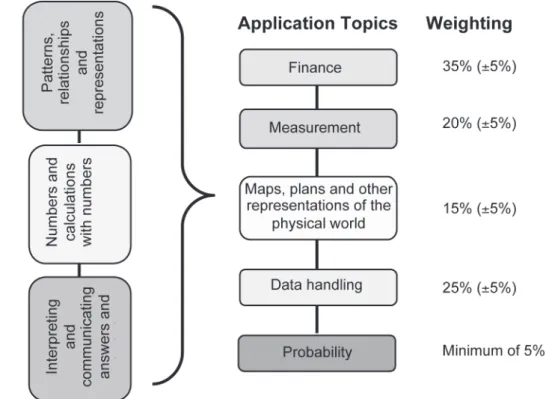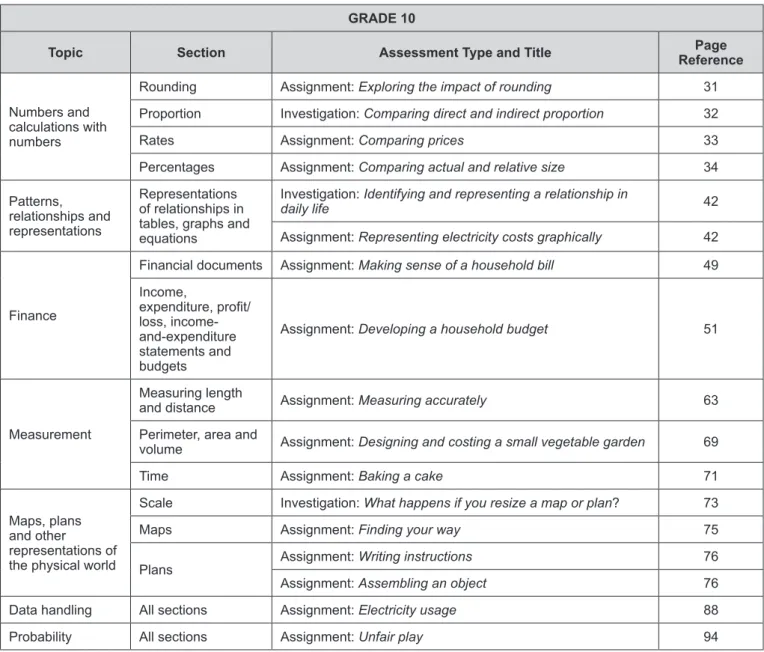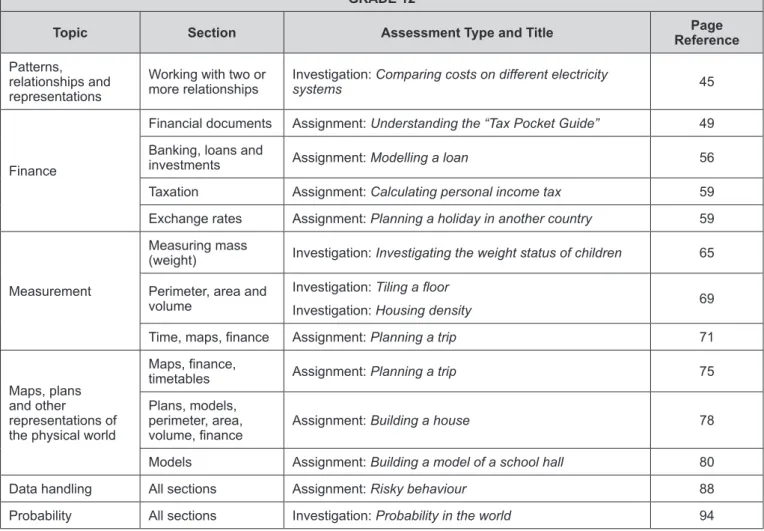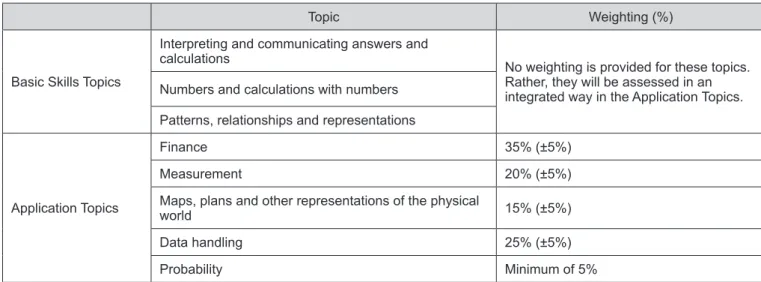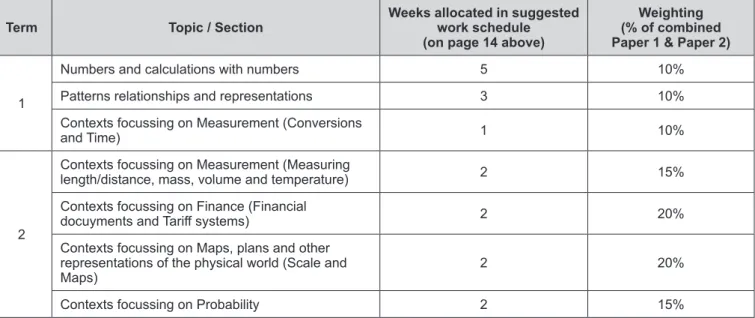Background
General aims of the south african Curriculum
- Foundation Phase
- Intermediate Phase
- Senior Phase
- Grades 10-12
- What is mathematical literacy
- Progression in mathematical literacy
- overview and weighting of topic
- suggested time allocation
- suggested work schedule
Probability will be examined in the context of one or more other questions. Probability will be examined in the context of one or more other questions.
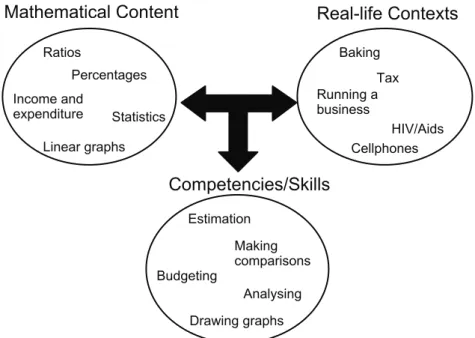
Content and sCoPe oF ConteXts Per toPiCs
This section of the CAPS document provides a detailed overview of the content and/or skills and suggested contexts to be taught in each grade level. This provides a clear description of the expected progression in terms of content and context from Grade 10 to Grade 12.
Simple tasks in the familiar context of the household Larger projects in familiar contexts of the household. Numerical concepts to be used in the context of: • Finances → personal and/or household finances • Measurement → simple tasks in the familiar environment of the household. Maps, plans and other representations of the physical world → maps and plans of less known contexts and/or structures • Data handling → data related to the.
To: Make sense of scenarios involving the subjects of Finance, Measurement, Maps, plans and other representations of the physical world, Data Management and Probability. To: Make sense of contexts and problems involving the subjects of Economics, Measurement, Maps, plans and other representations of the physical world, Data Management and Probability. To: Determine the cost of production and/or cost of a product or service, with an understanding of the difference between these two costs.
See the Maps section of Maps, Plans, and Other Representations of the Physical World for more details on the specific maps that students should be working with in Grade 12. Additional comments 11 and 12: * See the topic Maps, Plans and Other Representations of the Physical World for more details on the different types of scales, maps, plans and models and the specific calculations involving scale that students are expected to perform. Criticize aspects of the layout and/or design of the building and make suggestions for changes.
Assessment of mathematical literacy focuses specifically on the topics of using finance, measurement, maps, plans and other representations of the physical world, handling data and probability. Both the content and contexts of the task will likely be familiar to the learner. Contexts focusing on maps, plans and other representations of the physical world (scale and maps) 2 20%.
Read the value(s) of given dimensions on the floor plan (e.g. the length of the wall is 4 m).

Basic Skills Topics
Application Topics
Assessment is a continuously planned process of identifying, collecting and interpreting information about student performance using various forms of assessment. It includes four steps: generating and collecting proof of performance; evaluate this evidence; recording the findings and using this information to understand the student's development and thereby help to improve the learning and teaching process. In both cases, regular feedback should be given to the learners to improve the learning experience.
Consistent with course objectives, the assessment of mathematical literacy in mathematical literacy should measure the extent to which students are able to understand scenarios based on authentic and realistic, familiar and unfamiliar real-life contexts, by relied on both mathematical and non-mathematical ones. techniques and/or considerations. Some assessment tasks may more clearly give students the opportunity to demonstrate their understanding of content and/or specific mathematical skills (eg the ability to 'solve equations' or 'calculate statistics such as mean, median and mode for different data sets'), while other assessment tasks may be less focused on specific mathematical content and rather draw on a range of content and/or skills from a range of content topics to explore and understand an authentic context. Teachers should design assessment tasks that provide students with the opportunity to demonstrate both competence in mathematical content and the ability to use a variety of mathematical and non-mathematical techniques and/.
It is expected that the Basic Skills Topics of Interpreting and communicating answers and calculations, Numbers and calculations with numbers and Patterns, relationships and representations will be integrated throughout all subjects. Although teachers may choose to use assignments, investigations and tests to exclusively teach specific concepts and/. Maps, plans and other representations of the physical world, Data Handling and Probability, and their ability to use number concepts and equations, tables and graphs in an integrated way to make sense of those contexts.
Formal assessment
The levels of this taxonomy are described in Appendix 1 and are illustrated by reference to an assessment task (Responsible use of paracetamol) given in Appendix 2. When designing assignments, surveys and especially tests and exams, teachers should use the following guideline. to determine the number of marks to assign to questions at each level of the taxonomy. It is important to point out that in order to promote the vision that Mathematical Literacy involves the use of both mathematical and non-mathematical techniques and considerations in the exploration and understanding of authentic real-life scenarios, this taxonomy should not be seen as being exclusively associated with different levels of mathematical calculations and/or complexity.
When determining the degree of complexity and cognitive complexity of the task, it is also necessary to take into account the extent to which the task requires the use of integrated content and skills derived from various topics, the complexity of the context in which the problem is posed, the influence of non-mathematical considerations on the problem and the extent to which requires the learner to understand the problem without guidance or assistance.
Programme of assessment
- Programme of assessment in Mathematical Literacy
- Examinations for Grades 10, 11 and 12
By the end of the year, students must complete two assignments and two researches. In the 12th grade, one of the assignments in the 2nd and/or 3rd term must be an internal exam. The tables below provide a summary of the various proposed assessment tasks included in this document. Table 3: Summary of the proposed assessments listed in the CaPs document for grades 10 and 12, grade 10, subject area assessment type and title page.
Measuring precisely 63. volume Task: Designing and costing a small vegetable garden 69. representations of the physical world. The purpose of this paper is to assess understanding of the core content and/or skills outlined in the CAPS document in the context of authentic real-life problems. Contexts used in the Paper 1 exam will be limited to those specified in the Curriculum Outline section of the CAPS document, so the contexts used in this exam will be familiar to students.
The purpose of the Level 2 questions in this paper is to give students greater access to the contexts in which problems are located. Contexts used in a Paper 2 exam will include both familiar and unfamiliar contexts and are not limited to those specified in the Curriculum Outline section of the CAPS document. It is not the intention of this document to prescribe the content and weighting of the various subjects covered in these half-yearly examinations.
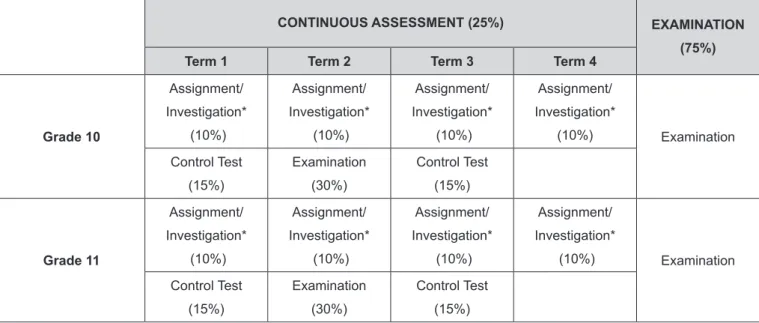
This means that in 10th grade teachers can choose to include questions that assess the content, skills and contexts covered in the topics of basic number skills and calculations with numbers and patterns, relationships and representations (both of which determined to be learned in quarter 1 in the work schedule provided at the beginning of this document). In Grade 11 teachers may choose to include questions that assess the content, skills, and contexts covered in the Foundational Skills topic of Models, Relationships, and Representations (which is scheduled to be taught in Term 1 according to the work given at the beginning of this document). Teachers can decide on an appropriate weighting of topics assessed in the exam, perhaps as determined by the amount of content covered in a topic or section and the amount of time required to teach the topic or section.
The table below shows an example of a possible subject weighting for a Class 10 mid-term examination (across both Paper 1 and Paper 2). Teachers will record actual grades against the assignment using a record sheet; and report percentages in relation to the subject on the students' report cards.
Tasks in applying routine procedures in familiar contexts level of the Mathematical Literacy Taxonomy require learners to perform familiar procedures and complete common tasks in familiar contexts. In the responsible use of paracetamol task in appendix 2 below, Questions 1.4 and 1.5 are at the application of routine procedures in familiar contexts level of the taxonomy. Tasks in the application of multi-step procedures in a variety of contexts level of the Mathematical Literacy taxonomy require learners to solve problems or complete tasks using known procedures and methods, but where the procedure or method is not immediately obvious from the way on which the problem is not stated.
In the responsible use of paracetamol task in appendix 2 below, Questions 2.1.2 and 3.2 in the application of multi-step procedures in a variety of contexts are level of the taxonomy. In the responsible use of paracetamol task in appendix 2 below, Questions 3.1.2 and 3.3 are on the reasoning and reflection level of the taxonomy. Calculate how many mg of paracetamol each of the following children can safely take per dose.
Determine the cost price of an item by adding up cost values given for the component parts of the item. Investigate and describe the impact of increasing monthly repayments on the total cost of the loan/investment. Read information directly from a particular questionnaire/survey (for example, the name of the organization for which .. the questionnaire is being administered).
General
